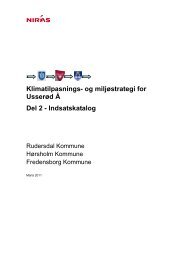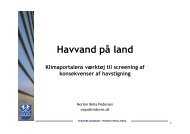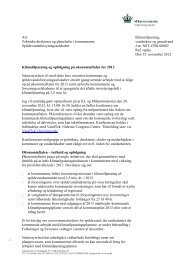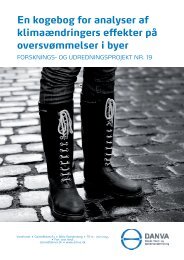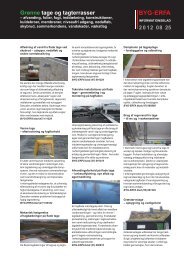Mapping climate change - barriers and opportunities for action
Mapping climate change - barriers and opportunities for action
Mapping climate change - barriers and opportunities for action
Create successful ePaper yourself
Turn your PDF publications into a flip-book with our unique Google optimized e-Paper software.
2. Summary <strong>and</strong> conclusions<br />
The significance of <strong>climate</strong> <strong>change</strong> up to 2050<br />
The Danish <strong>climate</strong> will <strong>change</strong> gradually in the future. In the years up to 2050, <strong>and</strong> in particular in<br />
the longer term, the <strong>climate</strong> will present a number of challenges. As a common starting point <strong>for</strong><br />
<strong>climate</strong> <strong>change</strong> adaptation ef<strong>for</strong>ts in Denmark, since 2010 the recommended <strong>climate</strong> scenario has<br />
been the A1B scenario from the Intergovernmental Panel on Climate Change (IPCC). Detailed data<br />
from the Danish Meteorological Institute are available <strong>for</strong> this scenario via the Danish Portal <strong>for</strong><br />
Climate Change Adaptation (www.klimatilpasning.dk). The annual average temperature in<br />
Denmark is expected to increase by about 1.2 o C up to 2050. Annual average precipitation is<br />
expected to increase by about 7% up to 2050, with the highest increase during winter. Denmark will<br />
be located on the border between two zones: with more summer precipitation in northern<br />
Sc<strong>and</strong>inavia <strong>and</strong> less in central <strong>and</strong> southern Europe. Danish waters will become warmer, less salty<br />
<strong>and</strong> with higher sea levels. Weather extremes will generally be more likely <strong>and</strong> this will mean more<br />
intense <strong>and</strong> more frequent heatwaves, storms <strong>and</strong> rainfall, as well as longer periods of drought. For<br />
example, new calculations indicate that, in 2050, a 50-year storm in Denmark will be 10% more<br />
intense.<br />
The more precise magnitude of <strong>climate</strong> <strong>change</strong> 50-100 years from now depends on future<br />
greenhouse gas emissions <strong>for</strong> example, <strong>and</strong> projections are associated with great uncertainty, as is<br />
the magnitude of the impacts of <strong>climate</strong> <strong>change</strong> <strong>for</strong> Denmark. Climate simulations, <strong>and</strong> our<br />
underst<strong>and</strong>ing of the uncertainties linked to them, are improving all the time. Moreover, local <strong>and</strong><br />
regional effects of <strong>climate</strong> <strong>change</strong> may differ. Decision-making on <strong>climate</strong> <strong>change</strong> adaptation<br />
initiatives will there<strong>for</strong>e be subject to some uncertainty <strong>and</strong> this constitutes a challenge in itself <strong>for</strong><br />
municipalities, enterprises <strong>and</strong> individuals when prioritising ef<strong>for</strong>ts, including the scope of these.<br />
Consequently, adaptation initiatives risk being either over- or under-dimensioned relative to what is<br />
economically ideal. It is there<strong>for</strong>e important that <strong>climate</strong> <strong>change</strong> adaptation initiatives allow <strong>for</strong> later<br />
adjustments <strong>and</strong> that the knowledge base is updated on a regular basis.<br />
A review of the significance of <strong>climate</strong> <strong>change</strong> up to 2050 <strong>for</strong> the individual sectors <strong>and</strong> industries<br />
shows that Danish society may experience both positive <strong>and</strong> negative impacts.<br />
The positive impacts will relate primarily to the higher temperatures which will result e.g. in a<br />
longer growing season <strong>and</strong> increased productivity <strong>for</strong> <strong>for</strong>estry <strong>and</strong> agriculture. Milder winters will<br />
moreover reduce energy consumption <strong>and</strong> construction costs, as well as the costs of winter weather<br />
preparedness <strong>and</strong> road salt.<br />
The negative impacts of <strong>climate</strong> <strong>change</strong> will relate primarily to more frequent extreme rainfall,<br />
elevated sea levels <strong>and</strong> more powerful storms which can lead to flooding <strong>and</strong> damage to<br />
infrastructure <strong>and</strong> buildings as well as erosion along coasts.<br />
Division of responsibilities<br />
The municipalities <strong>and</strong> citizens will, <strong>for</strong> the most part, be responsible <strong>for</strong> addressing <strong>and</strong> adapting to<br />
<strong>climate</strong> <strong>change</strong>. Owners of buildings will have to decide whether they want to adapt homes <strong>and</strong><br />
other buildings. The municipalities, which are responsible <strong>for</strong> a large number of areas such as<br />
wastewater treatment <strong>and</strong> a large part of the road infrastructure, decide themselves how they want to<br />
tackle the challenge from more intense precipitation, <strong>for</strong> example. The state plays a role in terms of<br />
adapting state-owned buildings, l<strong>and</strong> <strong>and</strong> state-owned infrastructure to <strong>climate</strong> <strong>change</strong>.<br />
6






